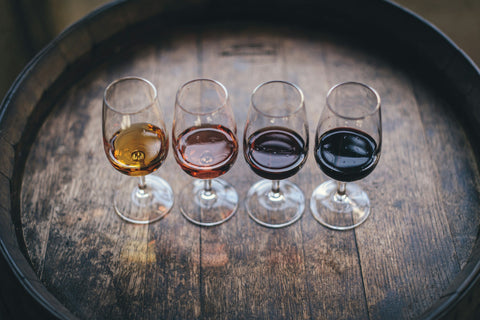God created man and water, man created wine and the man of the Douro created Port.- Alfredo Saramago
Port wine is bottled elegance per se; embodying the essence of Portuguese tradition and craftsmanship, each sip of this iconic nectar seems to tell the rich story of its unique terroir in the Douro Valley.
From the rich Ruby Port to the freshness of white Port and the elegance of Vintage Port, we introduce you to each style of Port with tasting tips for an unforgettable sensory experience. Whether you are a novice or a connoisseur, this article will accompany you through each step of your journey into the world of the rich and varied flavours of Port wines.
From the Douro to the world
The history of Port wine is closely linked to that of the Douro wine region in northern Portugal. The first traces of viticulture in this region date back several millennia, but it wasn't until the 17th century that Port wine as we know it today began to take shape.
In the 17th century, the Port wine trade took off thanks to growing demand in England. At the time, England was in conflict with France, its main wine supplier. English merchants turned to Portugal where they discovered the rich, full-bodied wines produced in the Douro Valley. They quickly realized that these wines could be fortified by adding grape brandy, making them more resistant to the long sea voyages to England.
Over time, Port wine has become a true institution, exported all over the world. The Douro region was officially demarcated and protected as a wine-growing area in 1756, making it one of the oldest demarcated wine regions in the world.
Today, Port wine continues to enjoy its status as a prestigious and high-quality beverage. The tradition of production remains largely unchanged, with many quintas (wine estates) still producing Port wine using artisanal methods passed down from generation to generation. The Douro’s unique climate combined with traditional production methods results in Port wines of exceptional quality.
A unique production process
What sets Port wines apart from other wines is their unique production process. The making of Port wine begins in the steep vineyards of the Douro Valley, where grapes have been grown on stone terraces for generations. Once the grapes have reached optimum ripeness, they are harvested and transported to the winery.
At this point, the fermentation process begins, transforming the grape juice into wine. However, this is only the beginning of the journey; before fermentation is complete, brandy is added to the fermenting grape must, stopping the process and leaving a significant amount of residual sugar in the wine. This method gives Port wines their sweetness and higher alcohol content.
After fermentation, the wine is transferred to oak barrels for ageing. This is where the different styles of Port begin to develop. Once the ageing process is complete, the wines are blended and bottled, ready to be enjoyed by wine lovers around the world. It is this skillful combination of tradition, craftsmanship and unique terroir that gives Port wine its worldwide reputation and unmistakable character.
The diversity of Port wines
Port wines are divided into several categories based on their style, age and the grape varieties used. Some Port wines are aged in oak barrels for many years, developing complex flavours and rich aromas.
Here are the main categories of Port wines:
Red port
- Ruby
Ruby Port is young and fruity, with intense aromas of red fruits and a deep ruby color. Aged in oak barrels for a relatively short period, it retains its freshness and liveliness.
- Late Bottled Vintage (LBV)
Aged in barrels for longer than Ruby, typically four to six years, it offers greater complexity. LBVs come from a single harvest and are bottled after some time in barrels.
- Vintage
Considered the “premium” category of Port wines, Vintage Port is produced from the best harvests of a single exceptional year. It is aged for two years in oak barrels before being bottled, where it is allowed to continue its evolution for several years before being released for sale. Vintage Port has an intense concentration of fruit, a robust tannic structure and exceptional ageing potential. This Port is often offered on special occasions such as birthdays, weddings or other important celebrations.
White Port
- White
White Ports are made from white grapes and aged in oak barrels. They offer delicate aromas of dried fruits and flowers with a refreshing acidity and an elegant finish.
- Lagrima
A sweet and luxurious white Port, with a higher sugar content than other white varieties.
Rosé Port
A less traditional style, Rosé Port is produced from red grapes, but with limited skin maceration to give it a pink hue. It can be dry or sweet.
Tawny Port
- Tawny
Tawny Ports are aged in oak barrels for an extended period, often several decades, which gives them an amber colour and complex aromas of dried fruit, caramel and nuts. They are available in a range of styles categorized by age, from young and fresh Tawny (10, 20 years) to old and rich Tawny (30, 40, 50 years).
- Colheita (Harvest)
A Tawny made from grapes from a single year, but aged in barrels for a specified period, usually at least seven years.
Each category of Port offers a unique taste experience, allowing enthusiasts to choose based on their personal preferences and the tasting occasion.

Tasting Port like an expert
Port wines offer a rich and complex range of flavours, from sweet and fruity varieties to more robust and spicy options. Choosing a Port wine depends on both your taste preferences and the occasion for which you plan to drink it.
To make your choice easier, we have compiled a list of tasting tips below that you can keep in mind to find the Port wine that suits you best.
Ruby Port
- Serving temperature: slightly chilled, between 12°C and 16°C.
- Tasting: enjoy it as an aperitif or alone at the end of a meal to enjoy its lively and fruity aromas.
- Suggested pairings: Ruby Ports, with their fruity profile and intensity, pair well with chocolate desserts, blue cheeses or dried fruits.
Tawny Port
- Serving temperature: slightly chilled, between 14°C and 18°C.
- Tasting: appreciate its complexity and sweetness by tasting it after a meal, alone or with desserts.
- Suggested pairings : younger Tawnys can be paired with nutty desserts, fruity pastries, aged cheeses or roasted poultry dishes. Older Tawnys, because of their complexity, can be enjoyed alone or with desserts with complex flavours.

White Port
- Serving temperature: very cold, between 8°C and 12°C.
- Tasting: ideal as an aperitif or with seafood dishes to accompany its freshness and acidity.
- Suggested pairings : white Ports, especially drier ones, can pair well with light starters, seafood, soft cheeses (e.g. Brie, Camembert), almonds or poultry dishes.

Vintage Port
- Serving temperature: at room temperature, between 16°C and 20°C.
- Tasting: open a bottle for special occasions and savour it slowly to appreciate its complexity.
- Suggested pairings : Vintage Ports, being high-quality wines, are often enjoyed on their own. However, if paired with food, blue cheeses, dark chocolate desserts or fruit cakes make excellent choices.

Rosé Port
- Serving temperature: very cold, between 8°C and 10°C.
- Tasting: ideal as an aperitif or with light dishes.
- Suggested pairings : this Port can be enjoyed with light starters, fruit salads, red fruit desserts, fresh cheeses or grilled chicken.
Late Bottled Vintage Port (LBV)
- Serving temperature: at room temperature, between 16°C and 18°C.
- Tasting: delicious when served alone or with rich, chocolatey desserts.
- Suggested pairings : LBVs are often paired with chocolate desserts, mature cheeses or even red meat dishes.
One more advice: if you plan to keep your Port wine for several years, opt for a Tawny or Vintage Port, which improve with age and offer an even richer and more complex taste experience.
------------------------------------------------------------------------------------------------
As we have seen, Port wine is much more than a delicious drink: it is the story of a unique region, a symbol of Portuguese heritage and tradition encapsulating centuries of know-how and passion.
And you, have you already found your favourite Port? Don't hesitate to share your tasting experience, your questions or your recommendations on our Facebook page, Instagram or by email. We'd love to hear from you!
Good to know:
- In the 18th century, Port wine was a favourite of the British court, which had close trading links with Portugal. Vintage Port was served at royal banquets and was considered a symbol of prestige and refinement.
- Port wine, although named after the city of Porto the same name, is primarily associated with the Douro region rather than the city of Porto itself. Its name derives mainly from its historical export through the Porto inlet. The region where this wine was produced has always been the Douro. Traditionally, Port wine was stored in Vila Nova de Gaia before being transported by ship and exported around the world through the Porto inlet.




Comments (0)
There are no comments for this article. Be the first one to leave a message!